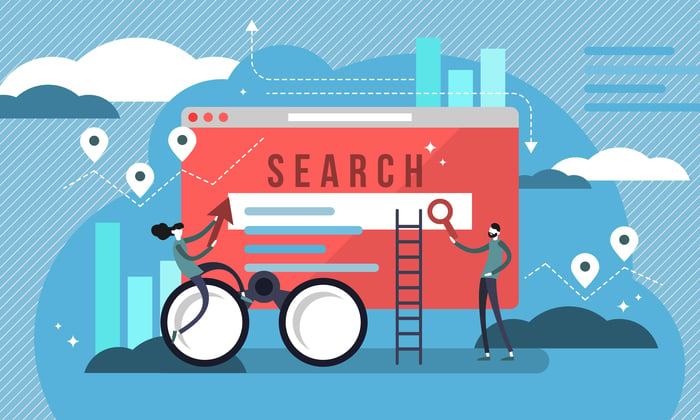
The SERPs (search engine results pages) are the listings you see whenever you type a query into a search engine.
For most of us (63%, plus 90% of mobile searches), that search engine will be Google, so if your website does well in Google’s SERPs, you’re going to see a lot of organic traffic.
When it comes to digital marketing, organic traffic is something of a Holy Grail. Why? Because as opposed to paid advertising, where you pay to get eyes on your content, organic clicks = free clicks.
However, the SERPs aren’t as straightforward as they once were, and there are several ways they can influence the amount of organic traffic you get.
So, let’s take a look at some of the different forms of traffic, how the SERPs affect them, and how you can get your website noticed in SERPs.
What Types of SERP Results Are There?
When you look at a Google SERP or any other search engine results page, you will see two types of results: organic and paid.

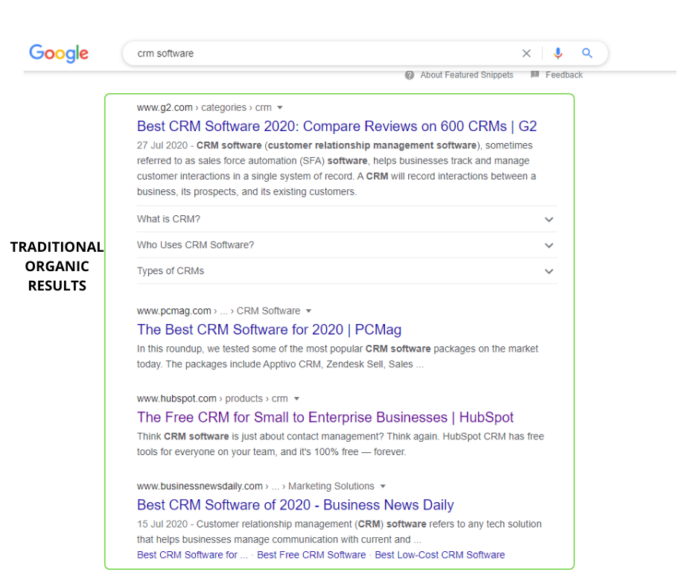
The results in the red box are paid listings, and all the green ones are organic listings. Each has its positives and negatives, and its influence on the SERPs.
Paid Search Results
Google AdWords allows websites to show up at the top of the SERPs for their chosen keywords, and they pay Google every time someone clicks their ad.
These results display at the top and bottom of the SERP and have “Ad” written in bold letters next to the URL.
As you can tell from their prominence at the top of the SERP, these ads can play a crucial role in getting targeted traffic to your website, and paid advertising campaigns are frequently run in conjunction with search engine optimization (SEO).
Organic Search Results
Our example search term of “CRM software” shown above shows the variety of ways a site can earn organic traffic from the SERPs.
We’re all used to the traditional organic listing of a meta title and description, but Google has added more SERP features in recent years. These features, such as the Featured Snippet and Knowledge Pack that you see in the example, can significantly impact organic traffic.
Whereas paid ads are a quick way to the top of the results pages (the highest bidders will generally win), competition for organic results is fierce and more complicated.;
However, if you learn how to feature your pages in the SERPs and understand how to earn people’s clicks, you will see far more organic traffic.
How Does SEO Fit In?
The SERP is where the vast majority of an SEO’s hard work plays out. SEO is responsible for ensuring that your website shows up in the SERPS, gets its fair share of clicks, and ensures users find what they are looking for once they click-through to your website.
The SERPs and SEO are intrinsically linked. The steps you take in this area are the keys to building organic traffic and achieving your traffic goals.
Too often, people hear about SEO and think it’s too complicated. But it’s a process, and simple SEO steps can lead you to the top of the results.
You can reach the top positions in the SERPs, and you can build a significant volume of organic traffic; you’ve just got to be consistent with your SEO and follow the right steps.
Small Changes in the SERP Results Make a Big Difference to Your Traffic
Google and the other search engines’ primary objective is to provide the user with the perfect search query results. To do this, Google uses algorithms that employ hundreds of different factors to determine each person’s best possible search results.
This level of personalization means the SERPs can vary greatly. Here are some of the key aspects of the SERPs that can largely impact your organic traffic.
Ranking on Page One
When you get to a results page, do you ever make it to page two? Or do you skim the top handful of results to see which will help you?
On a rare occasion, we might click to the second page to see what’s there, but most of us choose from the top results, which is why there’s a massive drop off in traffic between page one and page two of the SERPs.
On page one, listings earn 88.7% of all clicks, leaving all the other pages to fight it out for the remaining 11.3%. This difference just goes to show the importance of ranking on page one — most people never make it to page two.
Not All Positions are Created the Same
So you are thinking, “That’s great, if I make it to page one, then I’ve got everything sorted.”
Unfortunately, this isn’t the case.
Although getting to page one of the SERP is a great start, it’s only part of the challenge. There’s a massive variance between the click-through rate (CTR = number of clicks divided by the number of times your listing is shown) for the top three results and the CTR for ones lower down. These positions influence your organic traffic.
Here’s how the CTR works out for each position in the SERP:
- 23.3%
- 20.5%
- 13.3%
- 8.7%
- 6.3%
- 4.7%
- 3.8%
- 3.1%
- 2.7%
- 2.3%
You may have reached page one, but there’s clearly a huge incentive to get to the top.
What Aspects of the SERP Can Hold Your Organic Traffic Back?
In the last section, we mentioned that 88.7% of clicks go to page one results, but this doesn’t mean that 88.7% of all searches go to organic listings.
Only 41.45% of searches end up in an organic click.
What are the major obstacles to getting more organic traffic?
Paid Traffic
Paid ads feature prominently in the SERPs, so it’s no surprise that they attract plenty of clicks. This traffic is significant, but it only actually makes up around 3.58% of all clicks.
The reason for this is that paid ads don’t appear for every search term.
Generally, there are three types of searches: informational, navigational, and transactional. Advertisers pay for every click and want a good return on their investment, so they tend to focus on transactional search terms with the highest buyer intent.
While it’s still possible to get organic clicks for these transactional search terms, it’s a good idea to use Ubersuggest to figure out which search terms are more likely to have a high share of paid clicks.
If you look at the cost per click (CPC) of your keyword, you can see which keywords are likely to be dominated by ads. As you can see in the results below, “CRM tools” has a high CPC, which means there are likely lots of people competing for it, and a higher likelihood you’re going to be competing with ads.
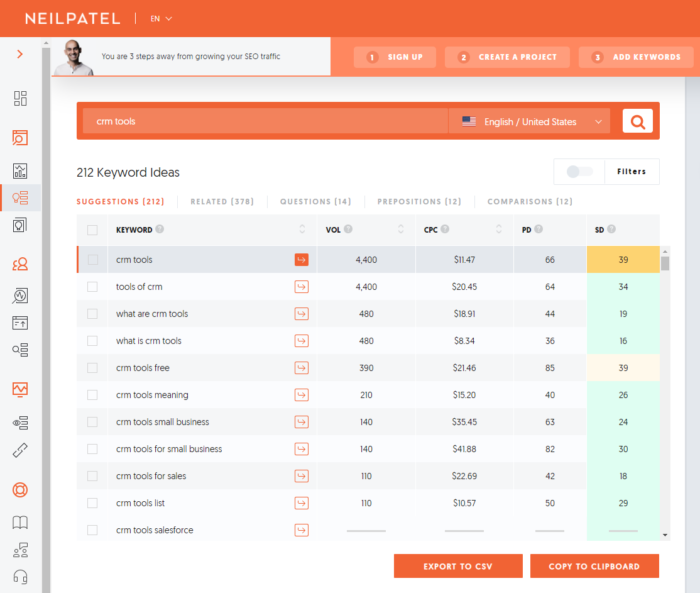
You can still gain organic clicks from these search terms, but you risk being pushed down the page by paid ads.
This search for “how to use CRM software” is a prime example. There are no organic results before the fold other than a video, meaning you have to scroll down before seeing even one traditional organic listing.
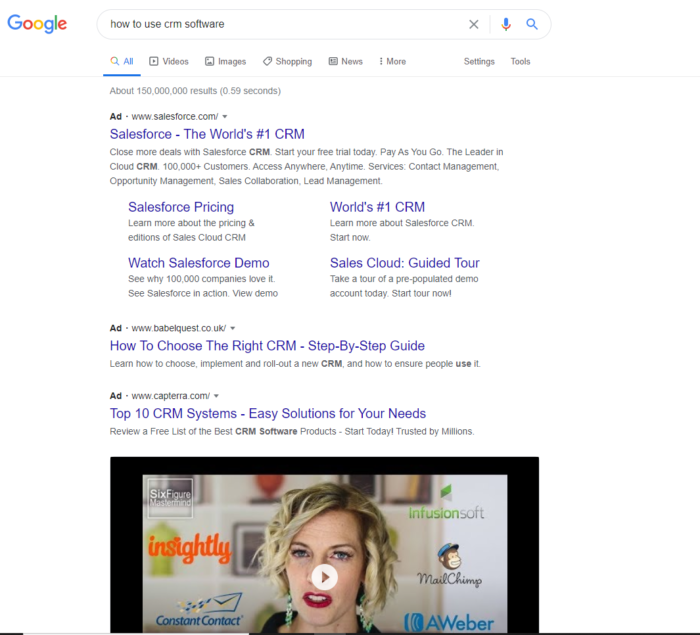
To do well in SERPs, you’ve got to be very focused on your keyword research to find the search terms with a realistic shot of gaining a prominent position in the SERP.
No-Click Searches
Google and the other search engines are always working to create a better search experience for their users. One way they have done this by introducing SERP features such as Featured Snippets and Knowledge Panels, giving people quick access to basic information.
In this search for “why use CRM,” we can see the power of the featured snippet.
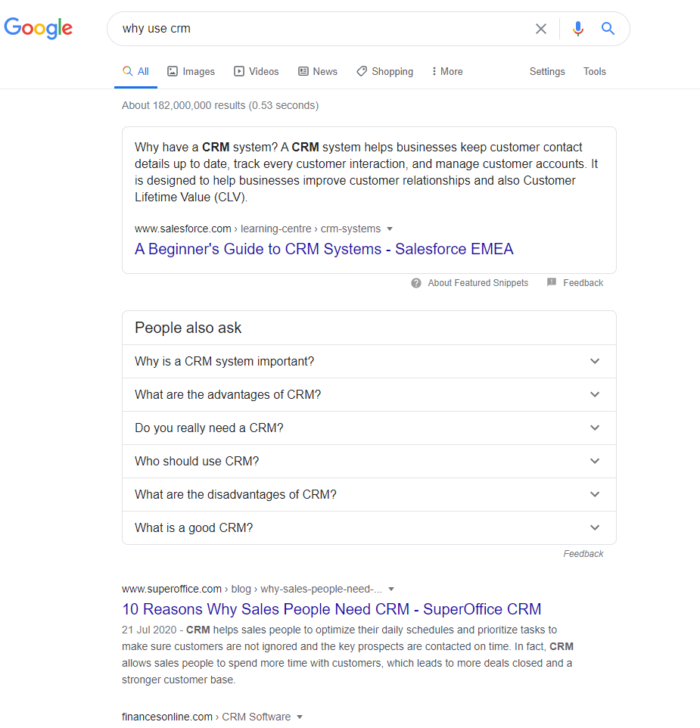
With the Featured Snippet, Google gave the user a cursory answer without having to click on a link. That means that even though Salesforce has won the snippet, and SuperOffice has the first traditional organic listing, neither got the click. It’s a no-click search because the user can read the Snippet.
Of course, lots of people are going to be curious enough to click to Salesforce or SuperOffice to find out more, but some users’ curiosity is going to be satisfied by the Featured Snippet. No-click searches account for 49% of all searches.
How Can You Use the SERP to Get More Organic Traffic?
Despite the competition with paid ads and the numbers of no-click searches, there’s still more than enough organic traffic to go around. However, you’ve got to know how to use the SERPs to your advantage.
Every SERP has its leader of the pack, and these folks put a lot of work into maintaining that position, so you’ve got to work hard to unseat them.
So, how do you do that?
The great thing about SEO is you’re in complete control of the content you put out and how you appear in the SERP. If you use this wisely, you can significantly boost your CTR and positively influence your organic traffic. Here’s how.
Produce High-Quality, Relevant Content
Google wants to provide users with the most relevant answers to their search query. To rank higher, your page has to accomplish two critical things. First, it has to be relevant for the search query, and second, it has to be high-quality content.
If you’re not achieving these two goals, then Google has no incentive to put you on page one because you’re not helping searchers achieve their goals.
This element is where your keyword research comes in handy to help you figure out precisely what your audience wants to see. When you know what your target audience is looking for, then you can provide the hyper-relevant content that attracts people to your website.
The more people who click to your site and engage with the content, the more the search engines will reward you for helping them do their job.
Make Your Listing Stand Out
You have complete control over what your listing looks like in the SERP. You can edit your title, meta description, and use other aspects like structured data, so use this opportunity to stand out from the crowd.
If you’re ranked number three for a search term, then the top listing has an advantage over you. But you can turn that around by crafting a more engaging, more relevant title and description. (Google usually uses the page’s chosen title and description but does occasionally modify it.) Your listing is out there competing for clicks, so treat it like an advert and work to entice users.
Get Those SERP Features
Google will keep using those “extra” SERP features, so you might as well embrace it and make sure your website is featuring in them.
The SERP features might lead to a higher percentage of no-click searches, but they can also lead to much higher CTRs when you win them. Hubspot found that sites that land featured snippets have a dramatically higher click-through rate.
Featured Snippets, Knowledge Panels, Local Packs, Shopping Results: they all stand out and draw in users. If you can snag those features, you’ve got an excellent opportunity to boost your organic traffic.
If you’re following good SEO practices, you have a solid chance to win those SERP features, but you can also take some specific steps to increase your chances of winning features, such as inclusion in a snippet.
Conclusion
A SERP is simply the results page users see when they type a query into Google or any other search engine, but it has the power to help you unlock the full potential of your website.
While they might seem complicated, there are tangible steps you can take to rank well in the SERPs and bring in the organic traffic you crave. While the search engines are always changing the SERPs, SEO and high-quality, relevant content can help you stay on top.
Now that you’ve got a good understanding of what the SERP is, it’s time to start optimizing your SEO to help your website achieve its goals.
What goals will more organic traffic help you reach?
Youtobe
No comments:
Post a Comment